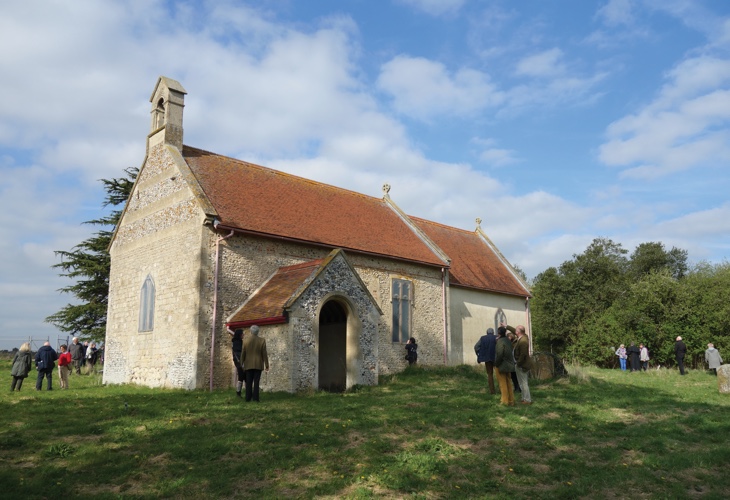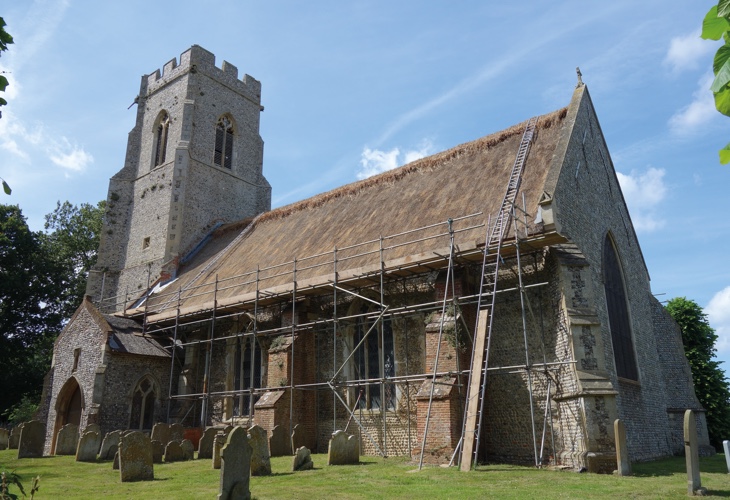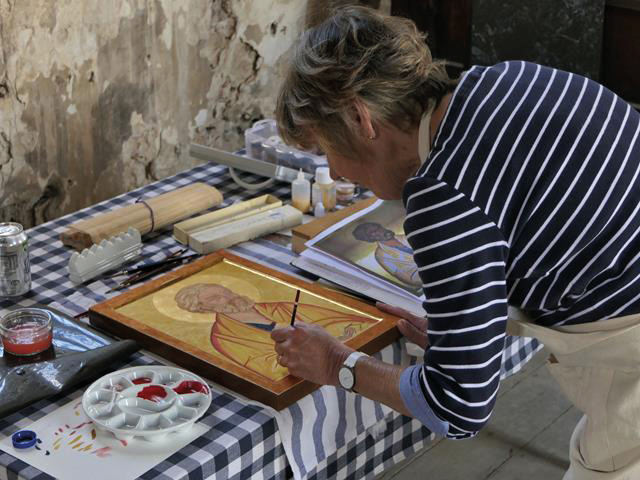A service of re-dedication of All Saints, Waterden, was attended by two council members of the Norfolk Churches Trust.
A most moving service of Evensong was conducted by the Bishop of Lynn, the Rt Rev Jonathan Meyrick. Fiona Fraser, on behalf of the trust, which also contributed towards the £272,000 cost of restoration, read the second Lesson.
As reported on the website in June, a previously unknown medieval wall painting also came to light during the work at All Saints, Waterden, between Fakenham and Wells.
When the north wall was being recovered with traditional limewash, some flaking plaster revealed the painting, which probably dates from the 17th century. Ashley Bannister, of restoration specialists Phoenix Build told the group that he saw some faint traces of colour in the design. Apparently, it was quite common to surround paintings with a wide black band.
The second finding, which lies close to the north door, was remains of flint foundations – again possibly the west wall of the former south aisle. This came to light as soil was removed to improve the drainage. Again, the south aisle arches can also be seen.
And the third element was found inside the church on the south wall. Part of the stonework of a large arch, probably dating from the 13th century, has also been exposed.
The church, thought to be post-Conquest, has a north and a south doorway with typical Norman features. As Barnack stone only became available in the years after 1066, it does help to give an indication of its likely date.
Since work started on the £235,000 project in January, Phoenix Build, based at Stalham, has completed major repair of the nave roof. It included replacement of rotten timbers and braces. Richard Bannister, who
heads the firm, was praised by architect Iain Walker for his skill in removing rotten timber and inserting new wood to strengthen beams, roof trusses and braces.
Although repairs had been carried out in 1992, this major project also included fitting new rainwater goods and crucially improving the drainage.
Mr Bannister’s son, Ashley, also said that repairs to several buttresses, which “soaking up moisture like a sponge” had also been completed. On the north wall, the wall was so damp that it could take a year or two for it to dry out completely, he added.
The National Lottery Heritage Fund awarded £211,100, including £29,100 for preliminary works, towards the total cost. The Norfolk Churches Trust gave £10,000, the Garfield Weston Foundation £7,500, the Holkham estate £3,000 and the Geoffrey Watling Charity £1,000.
The architect, Mr Walker, of Norwich-based Nicholas Warns Architects, took the nine-strong party including the Rector of Waterden, Father Clive Wylie around the church.
More information can be found in this recent article in the Daily Telegraph.
photograph courtesy of Nicholas Warns Architect Ltd
What’s left to be done?For the first time in its 1,000 year history All Saints’ Waterden will have gutters and down-pipes, painted in a tasteful dark green, with the rain water draining away into a sophisticated underground soak away system instead of pouring straight down onto the walls. These will be installed shortly. And, of course, there are a myriad of smaller works to be completed such as making good the ancient north and south doors, putting the bell back into working order, finishing off the car park with black park railings and a grass surface reinforced with mesh, putting up another sign at the entrance to the church in Waterden Lane, and generally tidying up and then resowing the grass around the church walls. . . . and what’s not going to be done?The project will secure the church’s fabric but its simple charm will remain unchanged. It currently has no electricity or water and that is how it will stay. So when you visit Waterden Church in the future you will find the same spiritual calm and peace and, unless you look very carefully, you won’t notice much change at all. |







